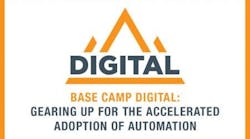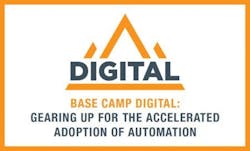The 10 obstacles to Industrial IoT…and how to overcome them
From the Base Camp Digital keynote presentation by Travis Cox, co-director of sales with event Platinum Sponsor Inductive Automation
A core tenet of digital transformation is the ability to nimbly respond to changing conditions. And that term—changing conditions—is a delicate way of describing the global events of the first half of 2020, which have affected how we live, how we work and how we congregate.In short, we’re doing all of it more remotely…more digitally. Hence, the Smart Industry Base Camp Conference long planned for this spring transformed into Base Camp Digital, a series of interactive online presentations with the industry experts who would have joined us at our live event.
Here, find features articles based on these presentations, covering a wide swath of the tools, techniques and technologies fueling the digital transformation of industry during this period of accelerated adoption of automation, and enabling us to nimbly adapt to those changing conditions.
The rich (and costly) legacy of industrial automation systems presents challenges that call for a new, future-proof architecture to meet the demands of digital transformation.
Most industrial organizations have gotten a good start in their digital-transformation journey. But enterprise-wide transformation remains elusive and—as Gartner puts it—most companies are stuck in a “trough of disillusionment.” They’re experiencing a sense of frustration stemming from inflated expectations following early excitement over the promise of digital transformation.
To understand why so many came to be stuck in that digital “trough,” you need look no further than the legacy architecture that continues to dominate SCADA systems. Today’s offerings are more closely coupled to some PLC brands than others. They are more proprietary than open, which limits integration with other areas of the business, from maintenance to ERP and beyond. Licensing arrangements, upgrades, backups, scalability and customization are also costly.
In short, despite excellent functionality in a closed environment, these legacy platforms lack future- proofing. Let’s explore how these obstacles can be overcome with tools designed for the era of digital transformation...
1. OBSTACLE: PEOPLE WHO ARE RESISTANT TO CHANGE
Many operational technology (OT) teams are used to doing things the same way. They may see adopting a new solution as too risky, time-consuming or difficult to learn.
Solution: Show the value using trial software
On the human side, seek a champion in the organization who is in a position to help you push your initiative forward. On technology side, the use of trial software has proven to be a good way to fast-track new initiatives with little to no risk involved when applied to small, well-chosen areas of the plant.
2. OBSTACLE: PERCEPTION OF NEEDING TO RIP & REPLACE
There’s a widespread perception that in order to implement new technology you’ve got to rip and replace your old system overnight. This isn’t just very intimidating; it’s impractical and risky. Fortunately that’s neither necessary nor recommended.
Solution: Implement a new, parallel infrastructure and plan ROI “wins” as you go
Building-out and testing the new IIoT system alongside your existing installation allows you to gradually transition devices from your old system. Just make sure the system is stable and remember to prioritize ROI wins as you go, mindful of long-term gains.
3. OBSTACLE: PAYING LICENSING COSTS & ACHIEVING ROI
Traditional, legacy licensing arrangements are a big obstacle to cost and an obstacle to ROI due to fees charged by the number of clients, users or tags (not to mention hefty implementation, maintenance contract and upgrade charges).
Solution: Software that offers an unlimited-licensing architecture
For example, new systems are licensed by the number of servers, which allows you to add more clients, tags and devices. This reduces costs and opens more connections for more data, new applications and an easier path to future expansion.
4. OBSTACLE: BRIDGING THE IT/OT GAP AND ITS PROPRIETARY SYSTEM LIMITS
IT and OT departments work with different environments and languages. IT is mainly concerned with data and security on the business side and works with open networks, databases and communication technologies. OT keeps operations running, but works with technologies such as SCADA, HMI, PLCs and RTUs that tend toward proprietary systems and vendors that are difficult to connect with IT.
Solution: Use open IT tools, technologies and standards
IT standards historically lead the way with standards adapted for OT purposes. This continues today with standards ranging from SQL and OPC-UA, SQL databases, HTML5 and MQTT, which enable IT/OT standardization for shared-data models, easier connectivity, greater interoperability and higher availability. This tact enables full IIoT scalability for ready integration from automation, IT and mobile apps, which is especially relevant in light of the COVID-19 pandemic’s increased demand for remote access.
5. OBSTACLE: LOW BANDWIDTH AND A LACK OF OPEN STANDARDS
Systems that lack enough bandwidth can’t be scaled up, and without open standards, tasks such as upgrades and data migration from OT to IT become overly complicated.
Solution: Implement an MQTT architecture
MQTT, originally built for the industrial setting, was adopted by the IT world to become the leading messaging protocol for IoT, as it is extremely efficient, lightweight, secure and robust. Now it’s come full circle. One major advantage for SCADA is that it makes real scalability possible because it decouples from devices and software, providing a scalable middleware solution. As such, it can provide a single source of the truth (i.e., tag database) accessible to both IT and OT software and hardware…even legacy PLCs.
6. OBSTACLE: PROCESSING DATA NEAR THE SOURCE
Once common communication standards such as MQTT are in place to allow communication, the challenge remains to extend the network in a way that ensures low latency and high security, even for legacy PLCs, many of which lack authentication and other security measures.
Solution: Add an edge-computing architecture
Edge-computing devices can range from dedicated computers to low-cost single-board embedded PCs running in existing multipurpose computers. They can poll PLCs at the source of real-time data, and add a layer of security while also opening IIoT data and functionality to plant and business systems for added ROI wins.
7. OBSTACLE: PROCESS VALUES ARE UNKNOWN
There are still places where data is missing that are desired for an IIoT initiative, but the cost and difficulty of connecting PLCs and remote devices is prohibitive.
Solution: Add cost-effective devices and sensors
IT standardization opens many new solutions for adding low-cost devices and sensors. Data can be directly accessed by many means, from remote I/O to wireless remote access using MQTT in a bandwidth-reducing publish/subscribe model. MQTT allows greater accessibility across all applications, from remote processindustry facilities to high-volume factory settings and lower-volume machine shops.
8. OBSTACLE: GETTING MORE DATA TO THE BUSINESS SIDE
Most organizations have yet to tap the benefits of getting more data to more people across the organization, and addressing the disconnect between people on the plant floor (or field) and the office.
Solution: Mobile-responsive HMI/SCADA/apps
This disconnect can be addressed by implementing more native mobile apps, ideally using HTML5. A well-designed app opens new connectivity to charts, dashboards and other performance-tracking features to OT users, while paving the way for IT integration.
9. OBSTACLE: BALANCING ACCESSIBILITY AND SECURITY
Increasing access to data outside operations raises the risk of cybersecurity threats and complicates integration.
Solution: Use modern cybersecurity practices
Adopting IT standards in HTML5 brings encryption protocols, multi-factor authentication and a full range of standards and practices, as well as infrastructure considerations that IT departments can readily help support.
10. OBSTACLE: SEIZING OPPORTUNITIES IN THE CLOUD
Most organizations lack an easy way to take advantage of the cloud in large part because they lack a simple cloud in large part because they lack a simple way to get their OT data into a cloud infrastructure, or leverage it properly once it’s in the cloud.
Solution: Cloud injectors and cloud visualization
Following IT standards at every step paves the way for using cloud injectors to safely bring edge-computing, SCADA-system tag data up through the MQTT infrastructure to any major cloud platform.
Once that data has reached the cloud, unlimited storage and greater compute capability enable advanced analytics, business intelligence, machine learning and other capabilities that can then be applied back to improve plant and business operations in a hybrid edge-to-cloud infrastructure.




